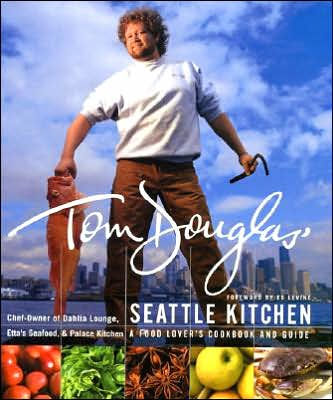There's a new culinary melting pot. It's called Seattle. Here you'll find everything from Japanese bento box lunches and Thai satays to steaming bowls of Vietnamese soups and all-American blackberry cobblers. No chef embodies this diversity with more flair and more flavor than chef/author/restaurateur Tom Douglas. And no book does it better than Tom Douglas' Seattle Kitchen.
Tom's creativity with local ingredients and his respect for Seattle's ethnic traditions have helped put his three restaurants and Seattle on the national culinary map. Join Tom and celebrate the Emerald City's rich culinary tradition: sweet I Dungeness crabs, razor clams, rich artisan cheeses, and deeply flavored Northwest beers. Share in the delight of sophisticated Washington wines, coffee fresh vegetables, fruits, and the exotic flavors of the Pacific Rim countries.
Tom Douglas' style is laid-back sophistication with a dash of humor. You can see it in the names of his chapters, "Starch Stacking," "Slow Dancing," and "Mo' Poke, Dadu" (this last title, courtesy of his daughter, Loretta, means "More Pork, Daddy"). And you can taste it in his signature dishes such as Dungeness Crabcakes with Green Cocktail Sauce, Roast Duck with Huckleberry Sauce and Parsnip-Apple Hash, Udon with Sea Scallops in Miso Broth, and Triple Cream Coconut Pie.
Try his hearty Long-Bone Short Ribs with Chinook Merlot Gravy and Rosemary WhiteBeans or spicy Fire-roasted Oysters with Ginger Threads and Wasabi Butter. Relax in the comfort of the comfort foods he prepares for his own family: Loretta's Buttermilk Pancakes with Wild Blackberries, Basic Barbecued Baby Back Ribs, and Five-Spice Angel Food Cake. They're all clear, simple recipes that'll have you cooking like Tom Douglas from the very first page.
But this is more than a cookbook; it's a food lover's guide to Seattle. Join Tom on a tour of his city with his list of top ten best things to do — and eat — in Seattle, from his favorite ethnic markets and neighborhoods to where to get the best breakfast.
Why not turn your kitchen into a Seattle kitchen? All it takes is a little help and inspiration from Tom Douglas.
There's a new culinary melting pot. It's called Seattle. Here you'll find everything from Japanese bento box lunches and Thai satays to steaming bowls of Vietnamese soups and all-American blackberry cobblers. No chef embodies this diversity with more flair and more flavor than chef/author/restaurateur Tom Douglas. And no book does it better than Tom Douglas' Seattle Kitchen.
Tom's creativity with local ingredients and his respect for Seattle's ethnic traditions have helped put his three restaurants and Seattle on the national culinary map. Join Tom and celebrate the Emerald City's rich culinary tradition: sweet I Dungeness crabs, razor clams, rich artisan cheeses, and deeply flavored Northwest beers. Share in the delight of sophisticated Washington wines, coffee fresh vegetables, fruits, and the exotic flavors of the Pacific Rim countries.
Tom Douglas' style is laid-back sophistication with a dash of humor. You can see it in the names of his chapters, "Starch Stacking," "Slow Dancing," and "Mo' Poke, Dadu" (this last title, courtesy of his daughter, Loretta, means "More Pork, Daddy"). And you can taste it in his signature dishes such as Dungeness Crabcakes with Green Cocktail Sauce, Roast Duck with Huckleberry Sauce and Parsnip-Apple Hash, Udon with Sea Scallops in Miso Broth, and Triple Cream Coconut Pie.
Try his hearty Long-Bone Short Ribs with Chinook Merlot Gravy and Rosemary WhiteBeans or spicy Fire-roasted Oysters with Ginger Threads and Wasabi Butter. Relax in the comfort of the comfort foods he prepares for his own family: Loretta's Buttermilk Pancakes with Wild Blackberries, Basic Barbecued Baby Back Ribs, and Five-Spice Angel Food Cake. They're all clear, simple recipes that'll have you cooking like Tom Douglas from the very first page.
But this is more than a cookbook; it's a food lover's guide to Seattle. Join Tom on a tour of his city with his list of top ten best things to do — and eat — in Seattle, from his favorite ethnic markets and neighborhoods to where to get the best breakfast.
Why not turn your kitchen into a Seattle kitchen? All it takes is a little help and inspiration from Tom Douglas.

Tom Douglas' Seattle Kitchen
288
Tom Douglas' Seattle Kitchen
288Hardcover(1ST)
Related collections and offers

Product Details
| ISBN-13: | 9780688172428 |
|---|---|
| Publisher: | HarperCollins Publishers |
| Publication date: | 12/28/2000 |
| Edition description: | 1ST |
| Pages: | 288 |
| Sales rank: | 266,909 |
| Product dimensions: | 8.00(w) x 10.00(h) x 0.76(d) |
About the Author
Customer Reviews
Explore More Items
YouTube® sensation Clara Cannucciari shares her treasured recipes and commonsense wisdom in a heartwarming remembrance of the Great Depression
Clara Cannucciari is a 94 year-old internet
In A Good Food Day, more than 100 recipes made with good-for-you ingredients make a good food day—a day when feeling good and eating well go hand in hand—easy and attainable.
After years of
A cozy collection of heirloom-quality recipes for pies, cakes, tarts, ice cream, preserves, and other sweet treats that cherishes the fruit of every season.
In this visually stunning collection of
From the acclaimed owner of Brooklyn’s Diner, Marlow & Sons, Marlow & Daughters, Reynard, The Ides, Achilles Heel, She Wolf Bakery, Marlow Goods, Roman’s, and the Wythe Hotel comes this
The Everyday Baker is the ultimate resource for anyone who likes,
Master delicious, sophisticated entertaining with acclaimed chef-fromager Tia Keenan’s foolproof pairings and quick recipes for elegant cheese plates and inspired accompaniments. A perfect gift
While other chefs paid dues on restaurant lines and at cooking schools, Brooks Headley was in the back of a tour van as a drummer in
Melted cheese between slices of toasted bread—the ultimate in comfort food. This mouthwatering cookbook features 39 grilled cheese recipes created by Heidi Gibson, winner of seven grilled
The first cookbook from Boston's acclaimed and beloved Myers+Chang restaurant
